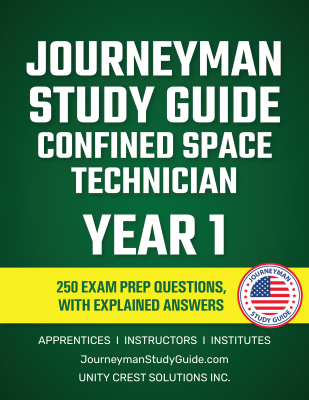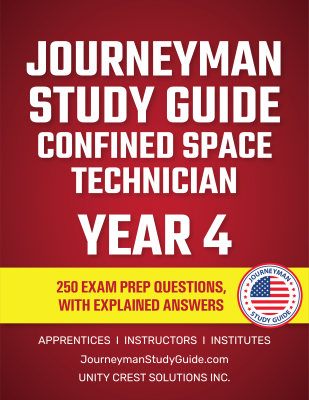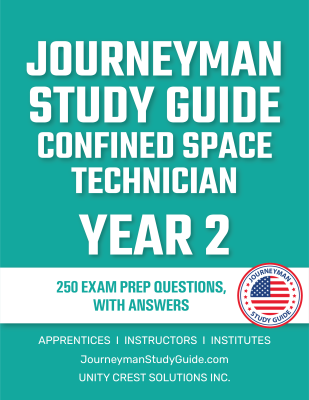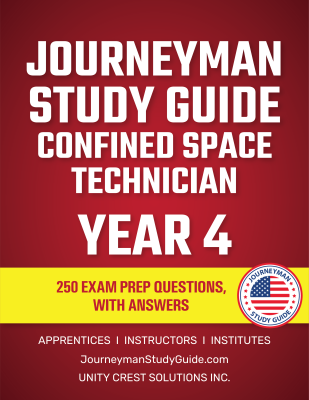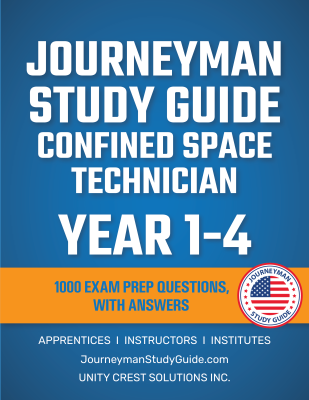Questions, Answers, & Explanations
Get clear explanations behind every answer, perfect for deeper learning and more thorough exam preparation.
Site Updates in Progress: Things might look different as we work on enhancing your experience.
What is a Confined Space Technician?
A confined space technician is a specialized worker trained to enter and perform tasks in hazardous, enclosed environments such as storage tanks, tunnels, pipelines, silos, and underground vaults. These spaces pose unique risks, including oxygen deficiency, toxic gases, engulfment hazards, and restricted access, requiring strict adherence to OSHA (Occupational Safety and Health Administration) regulations. Confined space technicians play a crucial role in industrial maintenance, emergency response, construction, and utility work across the United States.
Key Responsibilities
Confined space technicians are responsible for ensuring safe operations within enclosed or restricted workspaces. Their tasks include:
Skills and Traits for Success
Confined space technicians must possess a unique set of skills to handle the dangers associated with restricted work environments:
Industries Where Confined Space Technicians Thrive
Due to strict regulations and the hazardous nature of the job, confined space technicians are in high demand across various industries:
Why Choose This Career?
A career as a confined space technician offers job security, competitive wages, and opportunities for career advancement:
Get Certified and Advance Your Career
Certification is essential for career success in confined space operations. Our Q&A products, online tests, and study guides are designed to help you prepare for confined space certification exams, master OSHA regulations, and enhance workplace safety skills.
What to Expect on the Confined Space Technician Certification Exam
The Confined Space Technician Certification Exam assesses a candidate’s knowledge of OSHA regulations, hazard identification, atmospheric testing, and emergency procedures. Many employers, municipalities, industrial plants, and rescue teams require certification to ensure compliance with federal and state safety laws.
Exam Format
The certification exam consists of multiple-choice and scenario-based questions covering:
Key Topics Covered
Passing Requirements
Most certifying bodies require a minimum score of 70% to pass. Some programs include a practical skills assessment, where candidates demonstrate hazard assessments, atmospheric testing, and emergency response procedures.
Prepare with Confidence
Our Q&A study materials and interactive online tests are designed to help candidates reinforce key concepts, practice regulatory compliance scenarios, and improve test performance.
What Types of Questions Are on the Exam?
The Confined Space Technician Certification Exam tests knowledge of safety protocols, equipment operation, and regulatory compliance. Understanding the format will help ensure success.
Common Question Formats
Sample Questions
Study Smarter, Pass Faster
Our Q&A products help candidates focus on critical topics, while our Q/A Explanation guides provide deeper understanding. Our Online Tests simulate exam conditions for real-time assessment.
What Is It Like to Work as a Confined Space Technician?
A confined space technician’s job is highly specialized, requiring strict adherence to safety protocols while working in enclosed, hazardous environments. Each day presents unique challenges, from monitoring atmospheric conditions to executing emergency response plans. Technicians must be highly alert, physically fit, and comfortable working in restricted spaces.
Morning: Preparing for the Day
Midday: Entering Confined Spaces & Performing Tasks
Afternoon: Wrapping Up & Ensuring Compliance
Challenges & Rewards
Ready to Start Your Career?
Prepare for certification with our Q&A products, online tests, and study guides designed to help you master OSHA regulations and confined space procedures.
What Are the Long-Term Benefits of a Career as a Confined Space Technician?
Confined space technicians enjoy steady demand, competitive pay, and opportunities for specialization. Many professionals advance into safety management, industrial rescue, and hazardous material response roles.
Career Progression
Top Employers & Career Opportunities
Union & Certification Benefits
Why This Career Matters
Confined space technicians protect lives by ensuring safe entry, hazard mitigation, and emergency preparedness in some of the most dangerous work environments.
Take the Next Step
Advance your career with our study guides, Q&A materials, and interactive online tests tailored for confined space technicians.
How Much Can You Earn as a Confined Space Technician?
Wages for confined space technicians vary based on experience, location, industry specialization, and certification level. Due to the high-risk nature of the job, confined space technicians earn above-average wages in construction, manufacturing, and emergency response sectors.
Wage Breakdown by Experience Level
Factors That Impact Earnings
Job Stability & Financial Growth
As workplace safety regulations continue to tighten, the demand for trained confined space technicians remains strong, ensuring job security and competitive wages.
Maximize Your Earning Potential
Advance your career with our Q&A study materials, certification prep courses, and interactive online tests to enhance your knowledge and improve job prospects.
Essential Tools for Confined Space Technicians
Confined space technicians require specialized safety gear, monitoring instruments, and rescue equipment to perform their duties effectively.
Must-Have Tools for the Job
Top U.S. Suppliers for Safety Equipment
Recommended Training & Certification Programs
Why the Right Tools & Training Matter
Using the proper equipment and staying up-to-date with industry certifications ensures safety, efficiency, and career longevity in confined space operations.
Get Equipped for Success
Prepare for your certification with our comprehensive study guides, Q&A resources, and interactive online tests tailored for confined space technicians.
Where Can You Train to Become a Confined Space Technician?
Education and training for confined space technicians focus on OSHA compliance, hazard mitigation, and emergency response procedures. Many programs include hands-on training with safety equipment, gas detection devices, and ventilation systems to prepare students for real-world job scenarios.
Types of Training Programs
What to Expect in Training Programs
How to Choose the Right Program
Advance Your Skills with Professional Training
Becoming a certified confined space technician requires technical expertise, hands-on practice, and regulatory training. Our Q&A study materials and online tests help reinforce key concepts and prepare for certification exams.
Why Join a Union or Work with a Reputable Employer?
Union membership and working with trusted employers provide job stability, competitive wages, and career growth opportunities. Confined space technicians are represented by labor organizations such as LIUNA and IAFF, which offer safety training, benefits, and advocacy for workplace protections.
Benefits of Union Membership
Top Unions for Confined Space Technicians
Leading Employers Hiring Confined Space Technicians
What Employers Look For
How to Get Hired as a Confined Space Technician
Why Unions & Employers Matter
Unions and reputable employers ensure safe working conditions, competitive wages, and continuous training opportunities for confined space technicians.
Secure the Best Career Opportunities
Enhance your employability by getting certified and joining a union. Use our study guides, Q&A materials, and online tests to ensure success in confined space safety exams.
How to Stay Ahead in the Confined Space Industry
The confined space industry is constantly evolving due to advancements in safety technology, regulatory updates, and new industrial applications. Technicians who stay informed about OSHA requirements, emerging safety solutions, and industry best practices will remain competitive and highly valued in the workforce.
Emerging Trends in Confined Space Operations
Best Practices for Career Growth
Challenges & Opportunities in the Industry
Staying Competitive in the Job Market
The best confined space technicians continuously learn, adapt, and invest in their professional development. Our Q&A materials, Q/A Explanation guides, and interactive online tests provide the knowledge and preparation needed to stay ahead in this evolving field.
Get clear explanations behind every answer, perfect for deeper learning and more thorough exam preparation.
Quick and easy practice to test your knowledge anytime, anywhere—ideal for simple, on-the-go preparation.

